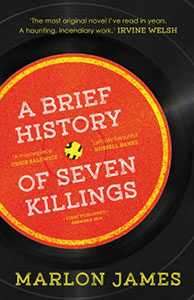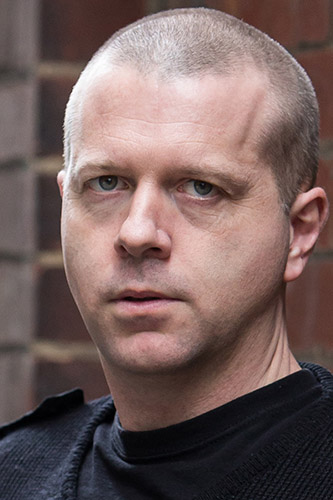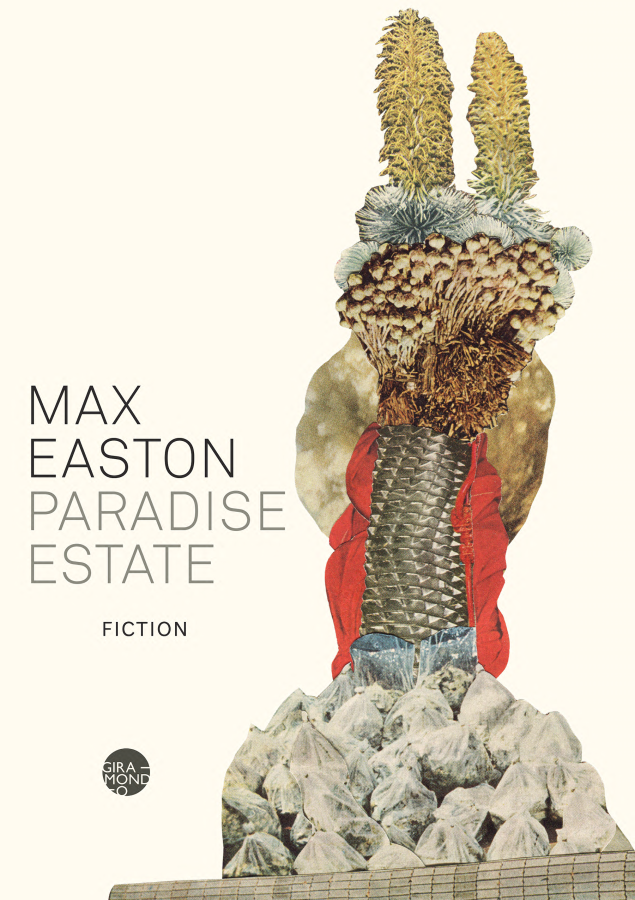If it no go so, it go near so: A Brief History of Seven Killings
In December 1976, Bob Marley agreed to perform the Smile Jamaica Concert in Kingston. Marley understood the free gig as easing the tension of a horrendously violent election campaign, in which gangsters allied with the social democratic People’s National Party were battling those aligned with the right-wing Jamaica Labour Party of Edward Seaga. Others, however, saw a partisan declaration, since the concert was the brainchild of the PNP’s Michael Manley. On 3 December, gunmen burst into the Marley compound at 56 Hope Street, opening fire with automatic weapons. Rita Marley was shot in the scalp, manager Don Taylor suffered severe wounds (initially judged fatal), and Bob himself took a bullet in the chest, mere inches from his heart.
Two days later, Marley appeared, as he had promised, on the stage at the Jamaican Heroes Circle, performing an epic version of ‘War’ to 60 000 people. He displayed his bandaged chest and sang the words:
Until the philosophy which hold one race superior
And another
Inferior
Is finally
And permanently
Discredited
And abandoned
Everywhere is war
Me say war.
Immediately afterwards, he fled the country.
*
In Marlon James’ huge novel A Brief History of Seven Killings, the attack on Marley lies at the heart of Jamaica’s descent from a moment of optimism in the mid-1970s into the cocaine-fuelled ultra-violence of the 1980s and 1990s, during which Kingston became the murder capital of the world. Readers might be puzzled by the emphasis on the wounding of a pop star in a decade-spanning narrative about criminality, corruption and social disintegration. In 2005 alone, a stunning 1674 people died from homicide on the tiny island, the highest rate of any nation on earth; in the light of such carnage, does it really matter who ordered the hit on the ‘Three Little Birds’ guy back in the ’70s?
But Marley should not be reduced to the stoner poster stuck up in college dorms. In Jamaica, he was the Tuff Gong – a whipsmart survivor of the Trenchtown slums, and one of the few men able to reason with the PNP’s chief gunman Bucky Marshall and then sit down with Claudie Massop, the ranking don from the JLP. On YouTube, you can find footage of the concert he played in the National Stadium in 1978, after he ended his self-imposed exile and returned to Jamaica. In the midst of an extended version of ‘Jammin’, Marley, sweat pouring from his face, begins scatting over the melody. ‘Could we have, could we have,’ he sings, ‘up here onstage here the presence of Mr. Michael Manley and Mr. Edward Seaga.’ Marley leaps in the air and the storm breaks with an enormous (and quite eerie) crash of thunder. A minute or so later, out come Manley and Seaga, the two men on whose behalf so many were dying. The politicians stand stiff and uncomfortable while Marley, dancing ecstatically, forces them to hug and shake hands.
In his song ‘Waiting for the Great Leap Forward’, Billy Bragg responds to a question about mixing pop and politics with ‘embarrassment and my usual excuses’. Certainly, most big political concert spectaculars have been faintly risible events – think of the corporate rock stars catching their private jets to Live Earth events, and then prancing about urging us to turn off our light globes. But the One Love Peace Concert of 1978 still seems different, not merely because it captures Bob Marley and the Wailers at their height of their considerable powers, nor because, given the carnage taking place in Jamaica, a reconciliation, even feigned, between the PNP and JLP (and, just as importantly, the gangsters Marshall and Massop), actually meant something, but because, in the footage, you can glimpse the potential for an entirely different political settlement as the twin parties of Jamaica’s political elite defer to Marley: a black representative of the Kingston ghetto and a member of the despised Rastafari sect.
That is the context for Marlon James’s book, a 680-page doorstopper in which Marley appears as ‘The Singer’ (glossed in the lengthy cast of characters as ‘the reggae superstar of the world’). Since the 1970s, all manner of theories have proliferated about the attack on the Marley compound. Some focus on a race-fixing scheme, in which rude boys hanging around Hope Street compound seem to have double-crossed some local badmen, an offence for which Marley, as their patron, was held responsible. But it is impossible to ignore the fevered political atmosphere of 1976, in which support for the PNP by a figure as prominent as Marley could not go unnoticed, both at home and abroad.
In the mid-1970s, Jamaica was a Cold War flashpoint, particularly as Michael Manley drew closer to Castro’s Cuba. Thereafter, Washington more-or-less openly backed the free market JLP of Edward Seaga – or ‘CIA-ga’, as the Rastas called him – even as the party bankrolled gunmen or ‘dons’ in the ghetto areas (‘garrisons’) it controlled. The former CIA agent Philip Agee, who appears in James’ book as ‘William Adler’, claims his old agency knowingly supplied guns to the forces of the JLP. It was in this period that the fearsome Shower Posse emerged, an outfit taking its name from the JLP promise ‘Blessings will shower from the sky and money will jingle in your pockets’ – as well as from its propensity to shower its enemies with bullets.
In Killing Hope (2004), William Blum documents in detail the escalation of CIA operations in Jamaica from 1976: a program of economic destabilisation and covert terrorism, in which huge quantities of weapons came into the possession of JLP gangsters like Lester ‘Jim Brown’ Coke. And where did these weapons come from? In his Dark Alliance (1998) – a controversial book but one that, in recent times, seems to have been largely vindicated – Gary Webb argues that, in the 1970s and 1980s, the CIA funded its clandestine military support for counter-revolutionary causes (most notably, the Nicaraguan Contras) by turning a blind eye to, or even fostering, the sale of cocaine. In passing, he notes that, during the campaign against Michael Manley, the Cuban CIA asset Luis Posada Carriles arrived in Kingston. Carriles was a weapons specialist and a terrorist but he was also, as Webb says, someone with ‘a history of engaging in arms-for-drugs deals’.
If, then, the attack on Marley came (as seems likely) from JLP-aligned gangsters using CIA weapons, what foreknowledge did the Americans have? Certainly, the CIA would have been as concerned as Seaga himself by Manley enlisting support from the island’s most popular son a few days before a crucial election. Did the Americans turn a blind eye to the attack – or did they, perhaps, give it the nod?
Of course, all of this is speculative and probably now unknowable, but many writers have imaginatively connected the dots: most recently, David Dusty Cupples in Stir it Up (2012), his novel about Marley and the CIA’s Jamaica campaign. But Marlon James – the author of The Book of Night Women (2010) and John Crow’s Devil (2005) – brings a literary sensibility to the material that allows him to do something special with it. In his acknowledgements, James discusses Faulkner’s As I Lay Dying (1930), which provided, he says, the key to his book, allowing him to write a big story that belonged to no single character. Thus A Brief History of Seven Killings opens with the ruminations of the murdered politician Sir Arthur Jennings, who has been thrown from a hotel balcony by his enemies. ‘When you’re dead,’ Jennings explains, ‘speech is nothing but tangents and detours and there’s nothing to do but stray and wander a while.’
The novel consists of those strayings and wanderings, an accretion of interior monologues from a huge cast of characters: Papa Lo (modelled on Claudie Massop), a jaded JLP gunmen, tiring of violence (‘Bad can’t compete against wicked,’ he laments); Josey Wales (Jim Brown), a younger and far more ruthless killer; Barry Diflorio, the CIA station chief in Jamaica running the anti-Manley campaign; Alex Pierce, a white reporter from Rolling Stone magazine, sent to write about Mick Jagger’s visit but sensing a bigger story; Nina Burgess, an uptown Jamaican girl who has a fling with the Singer; and many, many, many more.
The novel’s structure – and the relentless violence – recalls James Ellroy, except that, where Ellroy writes in a pastiche of 1950s hardboiled slang, many (though by no means all) of the monologues in A Brief History of Seven Killings are presented in Jamaican patois, the distinctive creole that blends West African and Arawak words and syntax with the seventeenth-century English of the slaveholders. This allows James to present, with a depth and richness, the consciousness of the low-level criminals caught up in murderous plots they don’t fully comprehend – individuals who could easily be dismissed as mindless thugs, but who possess their own complex rationales.
‘This is how it begin,’ the gunman Deemus tells us, and then outlines how the casual violence inflicted by Kingston’s corrupt police fuels a murderous hatred that leads, inexorably, to him joining the attack on the Singer, whose music he loves. We hear from the youth called Bam-Bam as he describes his mother, a sex worker, organising the killing of his father, before falling victim herself to the same gang of thugs. Bam-Bam flees deeper into the ghetto, where Papa Lo adopts him – and Josey Wales introduces him to cocaine and to murder. ‘It’s a hell of a thing,’ Bam-Bam says, ‘when a gun come home to live with you.’ (The names of these fictional gunmen – Bam-Bam, Weeper, Heckle, Treetop, Pig Tails, etc. – might seem excessive, until we recall that the roster of Jamaica’s historical badmen includes Feather Mop, Peter Cups, Waxie, Cheese Trix, and many others.) Meanwhile, Diflorio discovers one of his own field agents, Louis Johnson, working with the Cuban exile known as Dr Love (‘Because counter-revolution is an act of love, hermano, not war’) to equip Wales’s men with high-grade weapons, in a plan that may or may not be officially sanctioned.
In James’s version, the motivations for the ‘ambush in the night’ (as Marley, in his Survival album, labelled the attack) were many, varied and even contradictory, with the individual perpetrators harbouring different understandings of what they were doing. Johnson sees the gunmen as useful tools in his campaign to bring down Manley. Josey Wales resents Marley’s role reconciling Papa Lo with his rival Shotta Sherriff, recognising peace as damaging to business. Dr Love talks anti-communism – but he also puts the Jamaican dons in contact with the Medellin drug cartels.
The second half of the novel tracks the consequences of the schemes thus set in motion: the intensification of violence in Jamaica and, later, in New York, as Wales and his rude boys, equipped with hardcore ordinance, devote themselves to dealing coke and settling scores. James uses as one of his epigraphs a Jamaican proverb: ‘If it no go so, it go near so’ – roughly, even if the story didn’t unfold quite like that, this is a good approximation.
*
The pernicious effects of those events from the mid-1970s can still be felt today. In 2010, the Jamaican army had to fight its way into Kingston’s Tivoli Gardens to capture the don known as Dudus (Christopher Coke). Dudus was infamous for his ruthlessness – he was said to have cut one of his enemies up with a chainsaw. Yet more than 70 people died battling the military to protect him, and Bunny Wailer, the sole survivor of Bob’s original harmony trio, recorded a song in his honour. Why?
Dudus inherited the leadership of the Shower Posse from his father, Jim Brown (the Josey Wales of A Brief History of Seven Killings). That meant, until his capture, he was both a drug kingpin and a JLP operative (or ‘community leader’), whose construction company received millions of dollars in contracts from the JLP administration, largesse then distributed among the garrisons he controlled. Dudus’s criminality, like that of the other dons, was thus embedded both within the state and within the community – a process begun by those first shipments of weapons in 1976.
In A Brief History of Seven Killings, the gunman Tristan Phillips sits in a cell in Rikers Island in the early 1990s, and tells Alex Pierce why the attack on Marley still matters:
Even people who usually expect the worst did, if only for two or three month, start to think peace a little then a lot, then peace was all they could think about. Is like how before rain reach you can taste it coming in the breeze.
The book suggests that, for a brief moment, Jamaica might have been different. Behind the peace treaty lay something more fundamental: a future based on the new consciousness that the Singer embodied, an expression of the poor and the downtrodden and the excluded. Unfortunately, this is one of the weaker aspects of the novel. The Singer dominates A Brief History of Seven Killings, but only as an absent presence. Though he unifies the narrative, he appears primarily through the perceptions of others – and even then we rarely hear him speak or witness him act. He is less an individual than a Rorschach blot onto which the other characters project their hopes and fears.
You can see why James does this. It is a necessary element of the Faulknerish approach, transforming what might have been a tale about a Great Man into the collective story of a certain time and place. But the corollary is the blurring of his depiction of the specific Marley into the generic Singer. As a result, a novel about a musician says strangely little about music. The gunman Deemus is one of the few characters to talk about the Singer in terms of his songs. ‘Is not that music take away the pain,’ says Deemus, ‘but when it play I don’t ride the pain, I ride the rhythm.’ It’s a crucial point, but it remains undeveloped.
Understandably, James wants to rescue Marley from the kitsch images of bong hits and tropical holidays, re-situating him as a political player emerging from a particular historical setting. But Marley’s social significance cannot be disentangled from his art. If, as A Brief History of Seven Killings suggests, Marley came to embody a sense that (as Tristan Phillips says) ‘there was this once time when we could’a do it’, it was, first and foremost, through his music.
More than anyone, Marley brought Rastafari from the margins of society to the centre, so that a movement once regarded by respectable Jamaica as an apocalyptic criminal cult became one of the most identifiable products of the island. That popularisation happened because of a songwriting genius that universalised the doctrines of what had previously seemed an extraordinarily specific (even eccentric) religion. Through Marley’s songs, people around the world grasped their own situation via Rastafarian rhetoric, as opposed to the more familiar experience of those in the Third World understanding themselves in American terms.
Jamaica has always produced more than its share of musical talent. What was it that propelled Bob Marley into the pop stratosphere rather than his contemporaries, many of whom might have seemed more likely candidates for superstardom? Paradoxically, Marley still represents reggae for many music fans despite eschewing many of the characteristic elements of the genre: he never, for instance, cut a dub album, recorded with DJs or versioned over other artists’ riddims. So how did Marley’s compositions so capture their listeners that, for a few moments in 1978, he seemed, unquestionably, the most powerful person in Jamaica? It is a question that A Brief History of Seven Killings doesn’t answer – indeed, it doesn’t really ask.
Equally, for a novel so centred on violence, A Brief History of Seven Killings does not always convey action very effectively, partly because it relies so heavily on interior monologues. For instance, in a crucial episode, the bumbling journalist Alex Pierce awakes in a hotel room to find a gang enforcer standing above his bed. Yet the scene doesn’t pack nearly the punch you would expect because Pierce’s dawning awareness of the intruder gives way into an extended information dump. As he struggles to awake, we are conveyed his memories of the events that brought him to this point, so much so that we almost forget the killer looking down on him.
By its mid-point, the novel begins to sag and a certain repetition sets in. Partly, that is a matter of its length and complexity – the book rewards a second reading, though that’s a major allocation of time. But the last chapters, in which the whole affair reaches its inexorable conclusion, are absolutely riveting. By 1992, the real Jim Brown was in custody, awaiting incarceration in the General Penitentiary in Kingston. He was facing extradition to the US, where presumably he would be questioned about his rise to prominence. But before that could happen, he was found dead on the floor of his concrete cell. Somehow, impossibly, he had been burned to a cinder. In A Brief History of Seven Killings, James presents the final hours of Josey Wales, his Brown character: Dr Love, the Cuban terrorist, pays him a visit and, before the inevitable conclusion of their business, the two men talk:
I think about him sometimes.
Who?
The Singer … Sometimes I think the one thing people like me and him have in common is maybe we must die. That whatever we start, can’t finish until we get out of the way.
Was that really what happened? Did Jim Brown, before his death, think back to Marley and to what Hope Street had meant? If it no go so, it go near so.





